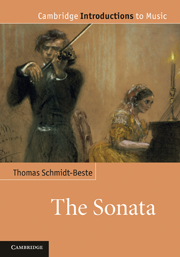Chapter 2 - Form
Published online by Cambridge University Press: 05 April 2013
Summary
The ‘free’ sonata in the seventeenth century
The history of the sonata in the seventeenth century is primarily a history of the sonata in Italy. The composition of music specifically for instruments – canzonas, toccatas, ricercars and capriccios – had flourished here since the middle of the sixteenth century, and from c. 1600 this provided a fertile ground for sonata composition, which spread from Venice and the cities and courts of northern Italy across the entire peninsula within a few decades. Table 2.1 provides a chronological and topographical overview, showing the primary composers and centres.
The scene north of the Alps, such as it was, was also dominated by expatriate Italians: the Venetian Giovanni Valentini (1582/3–1649) and the Veronese Antonio Bertali (1605–69), for example, were employed at the Imperial court in Vienna, the Mantuan violinist Carlo Farina (c. 1600–40) at the court of the Saxon kings in Dresden. Not until c. 1640 do we encounter a native composer of note in Germany: Johann Erasmus Kindermann (1618–55), who published four sonata collections in Nuremberg between 1640 and 1643. He was followed by Johann Rosenmüller (1619–84) and Johann Heinrich Schmelzer (c. 1620–80), slightly later by Johann Kuhnau (1660–1722), Dietrich Buxtehude (1637–1707) and, in Austria, Heinrich Ignaz Franz Biber (1644–1704). There was no sustained tradition of composing sonatas in England before Henry Purcell (1659–95), or in France before François Couperin (1668–1733).
Information
- Type
- Chapter
- Information
- The Sonata , pp. 20 - 172Publisher: Cambridge University PressPrint publication year: 2011
